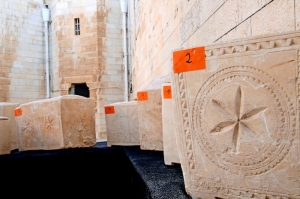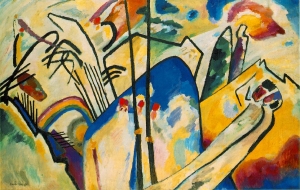|
Displaying items by tag: seized
A Picasso worth over $37 million that was seized from a yacht off the French island of Corsica has been transferred to a Madrid museum.
The painting, which was subject to a Spanish export ban, had been seized by French customs at the end of July.
On Tuesday, a team of Spanish police experts in national heritage flew to Corsica to retrieve the painting, and escorted it to the Reina Sofia Museum, which houses Pablo Picasso's large anti-war masterpiece Guernica, a police statement said.
Romanian anti-corruption prosecutors seized paintings, including some pieces signed by Pablo Picasso and Andy Warhol, from former Finance Minister Darius Valcov as part of a bribery probe.
Prosecutors found 101 paintings allegedly hidden by Valcov in different houses in Bucharest and the southern town of Slatina, which have been submitted for authentication, prosecutors said in a statement on their website. The seized paintings include three Picasso works and others signed by renowned Romanian artists Nicolae Tonitza and Stefan Luchian.
If not for the presence of the Carabinieri and its appearance in the Tribune de Geneve, this report of a Leonardo work missing for centuries that traded hands privately for “several hundreds million of Euros” would seem like a plot point from a poorly written thriller:
The financial Pesaro Brigade (East Central) and Carabinieri specialized in the theft of works of art of Ancona (center-east), announced that they had seized a painting attributed to Leonardo da Vinci, disappeared for centuries, and recently sold for several hundred million euros.
The Italian government on Wednesday said police had seized more than 5,000 ancient artifacts in a record 45-million-euro haul after dismantling a Swiss-Italian trafficking ring. Culture Minister Dario Franceschini said it was the country's "largest discovery yet" of looted works and consisted of 5,361 pieces, including vases, jewelry, frescoes and bronze statues, all dating from the 8th century BC to the 3rd century AD. The archaeological treasures came from illegal digs across Italy and "will be returned to where they were found," the minister told reporters.
Philippine authorities recovered on Tuesday more than a dozen paintings, including a work by Pablo Picasso, from an office and residences of lawmaker Imelda Marcos, a day after an anti-corruption court ordered their seizure.
The court ordered the family of the late dictator Ferdinand Marcos surrender eight paintings by famous European artists, declaring they had been illegally acquired with public funds.
An elderly Greek man was arrested for illegally obtaining a host of antiquities including more than a thousand coins of historical significance, police said on Monday.
Inside the 72-year-old man's house in Alexandria, a village in northern Greece, police found 1,061 copper coins, a thousand of which date from the Hellenistic period (third to first century BC), the Byzantine period (330-1453) and the Ottoman Empire.
Police said they were seized on Sunday, as well as 30 silver coins of the same periods, 16 copper rings and other jewelery of the Byzantine and post-Byzantine era.

The Israel Antiquities Authority announced that police have arrested a group of suspects accused of stealing ancient Jewish burial caskets from a cave near Jerusalem. The thieves were caught with 11 decorative stone ossuaries, or ancient coffins, that the Jewish people used for burial in the Second Temple period, 2,000 years ago. Some of the ossuaries still contain the bones of the deceased.
The suspects, from the West Bank, Jerusalem and Tel Aviv, were arrested on Friday, March 28, as they met prospective Jewish clients at the Hizma checkpoint north of Jerusalem. The ossuaries, which are covered in Hebrew inscriptions and traces of paint, were seized by investigators with the Israel Antiquities Authority’s Unit for the Prevention of Antiquities Robbery.
The Israel Antiquities Authority released a statement saying, “There is no doubt that the ossuaries were recently looted from a magnificent burial cave in Jerusalem.” Officials did not reveal how many suspects were arrested or what charges they may face.

German police arrested two people and raided 28 locations in an effort to halt a multi-million dollar international forgery ring responsible for selling fake paintings they claimed were by Russian avant-garde artists including Wassily Kandinsky (1866-1944). Apartments, business premises, and art galleries in Wiesbaden, Mainz, Suttgart, Munich, and Hamburg were searched by police officers. Over 1,000 items were seized including supposed forgeries and sales documents. Additional searches were carried out in Switzerland and Israel.
The forgers are believed to have sold over 400 works ranging in price from $1,332 to over $1 million since 2005, accruing more than $2.7 million. The two men who were arrested are believed to be the leaders of an international group of six counterfeiters. Private collectors in Germany and Spain acquired most of the fakes sold by the forgery ring.
Confidence in the German art market has been unstable since it was shaken by the largest forgery scandal to date in 2011. Art forger Wolfang Betrachhi was sentences to six years in jail after admitting to painting copies of works by Fernard Leger (1881-1955) and Max Ernst (1891-1976) and then selling them as masterpieces to unwitting collectors.

The Minneapolis Museum of Arts acquired a rare Renaissance bust of St. John the Baptist yesterday, May 8, 2013. Created by the Italian sculptor Benedetto da Rovezzano (1474-1554), the terracotta bust was one of the works handpicked by Hitler to appear in his Führermuseum, which never came to fruition. The institution was expected to house a massive collection of the most important works of Western Art in the historical canon.
Rovezzano’s bust was bought from Theresia Willi Lanz by Hitler’s special representative, Hans Posse, who was in charge of traveling across Europe seizing important works from Jewish art collectors and buying them from non-Jewish collectors. After the Führermuseum was never realized, the bust was hidden along with a number of important works by Leonardo da Vinci (1542-1519), Vermeer (1632-1675), and Michelangelo (1475-1564) in a salt mine in Austria. As it became clear that the Nazis would not win World War II, Hitler’s officials called for the destruction of the mine. However, the miners from the Austrian town wished to keep their livelihood intact and worked to save the mines and the art inside by removing inactivated Nazi bombs and setting them off through controlled explosions within the tunnels of the mines, saving the salt and the art but making them inaccessible. The bust was ultimately returned to the Netherlands.
Rovezanno was one of the most prominent sculptors during the high Renaissance and his bust of St. John the Baptist is well known among Renaissance experts. Created in Florence during the time when Leonardo, Michelangelo, and Raphael (1483-1520) were working there, the bust is the earliest Renaissance sculpture in the Minneapolis Institute’s collection. The bust of St. John the Baptist will go on view in the Minneapolis Institute of the Arts permanent galleries alongside other renowned Renaissance busts by Agostino Zoppo (circa 1520-1572) and Giovanni Battista Caccini (1556-1613).

The descendants of a Parisian art dealer are demanding that the Henie Onstad Art Center near Oslo, Norway return Henri Matisse’s (1869-1954) Blue Dress in a Yellow Armchair (1937) to them. Nazis seized the painting from its owner, Paul Rosenberg, prior to the outbreak of World War II. Ultimately, Rosenberg, one of the most prominent French art dealers and a personal friend of Pablo Picasso and Matisse, fled to New York and survived the war.
The painting in dispute has been a celebrated part of the Onstad’s collection since the museum was established in 1968. The work was donated to the fledgling institution by art collector Niels Onstad and his wife Sonjia Henie, an Olympic figure skater. Museum Director Tone Hansen attests that Onstad and Henie bought the painting from the Parisian Galerie Henri Benezit in 1950, unaware of its troublesome provenance. Hansen was unaware that Nazis had stolen the painting until the Art Loss Register, an organization that tracks lost and stolen paintings, notified him in 2012.
Art Registry documents show that Rosenberg purchased Blue Dress in a Yellow Armchair directly from Matisse in 1937. Following World War II, Rosenberg attempted to re-establish his business and tried to recover the 400+ works that had been taken from him by the Nazis. The painting was marked on Rosenberg’s personal documents as missing after the war. He also reported the painting missing to French authorities in 1946.
While Rosenberg’s heirs hope that the painting will be returned to their family, Norwegian law states that if a person has had an item in good faith for over 10 years, they are deemed the rightful owner. However, the argument is in contrast to the Washington Conference Principles on Nazi-Confiscated Art, which Norway is a part of.
|
|
|
|
|